-
About
- About Listly
- Community & Support
- Howto
- Chrome Extension
- Bookmarklet
- WordPress Plugin
- Listly Premium
- Privacy
- Terms
- DMCA Copyright
- © 2010-2024 Boomy Labs


 Stan Phelps
Stan Phelps
Listly by Stan Phelps
A collection of examples powering the upcoming book, Blue Goldfish by Stan Phelps and Evan Carroll. A blue goldfish is any time a business goes leverages technology, data and analytics to do a ‘little something extra’ to improve the experience for the customer. Are you using infosense to win profits and prophets?

Westpac is one of Australia’s big four banks and the second-largest bank in New Zealand. The financial institution is approaching 100 million customer interactions per month. The bank has been join the dots between the immense amount of information about their customers with a program called “Know Me.” The bank knows needs are driven by life stages and moments of truth in their customer journey. The bank utilizes SAS to drive insights about the customers through their data to create NBO’s, “next best offers.” By using a mix of offline transactional data and online behavioral data, the insights allow the bank to predict what the customer might need next. Bank tellers and customer service representatives can see an NBO when servicing a customer and extend the offer. How successful has Westpac been with conversion? They are currently converting over 40% of offers. Utilizing big data to identify a range of personalized “next best offers” has helped deliver $22 million to Westpac’s bottom line.
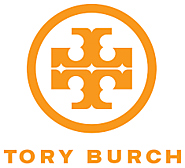
How do you connect online history with in store behaviors? Retailer Tory Burch has developed a system for customers and in store associates called “Client Book.” According to an article in Internet Retailer, “Client book enables customers to keep track of previous orders, wish lists and other information from online accounts. A shopper might put something into her wish list late at night, for instance, and a store associate keeping track could have that item ready on the shopper’s next store visit or prepare recommendations for other products.”

Homebase has partnered with IBM Commerce to tailor the experience to provide advice and inspiration across over 150 projects.
IBM has helped Homebase by leveraging analytics to understand and anticipate customer needs whether its online, in-store or via mobile. According to Homebase Marketing Director Jo Kendrick, the company has “transformed its digital presence into an interactive inspirational showroom that guides them [customers] through all their home improvement needs.”
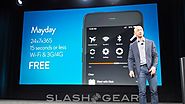
The Amazon Mayday button connects Kindle Fire HDX tablet owners to an Amazon customer service representative via webcam. Among tablet owners, 75% of customer service interactions now come via the button.

Train station LED display gives real-time data on carriages
In July 2014, Dutch train operators Prorail and NS announced plans to roll out platform-length LED displays that provide real-time information to passengers. The 180-meter LED strips show information on carriage crowdedness, as well as information on where carriage doors will open, which carriages are best for bikes and buggies, and where quiet carriages are located. The system utilizes infrared sensors in carriages that detect how full carriages have become. The announcement followed a successful 2013 trial.
Source: Trendwatching
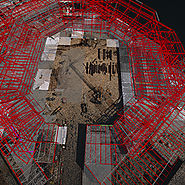
Once per day, several drones automatically patrol the Sacramento work site, collecting video footage. That footage is then converted into a three-dimensional picture of the site, which is fed into software that compares it to computerized architectural plans as well as a the construction work plan showing when each element should be finished. The software can show managers how the project is progressing, and can automatically highlight parts that may be falling behind schedule.
http://www.technologyreview.com/news/540836/new-boss-on-construction-sites-is-a-drone/
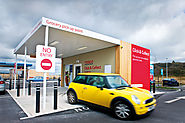
In 2010 the retailer launched a service called “Click and Collect." The service allows customers to order online, select a time window for pickup and retrieve their groceries at a defined collection center. According to an article in the Gulf News:
The service relies on its simplicity and convenience, said Ken Towle, Tesco’s director of internet retailing. For a £2 fee, a shopper’s purchases are picked, packed and stored at the drive-through point. When the customer arrives, an employee loads the shopping into their car.
“What customers like is they are in control,” Towle said. “They choose when they want it to be available. It de-stresses the whole experience for them.”
Is it working?
According to a report by Bloomberg . . . YES.
Tesco plans to triple the number of drive-through grocery collection points this year to win shoppers who prefer the convenience of picking up online orders to waiting at home for a delivery. The retailer is “fast accelerating” its Click & Collect service and will have 150 of the drive-through pods in parking lots by the end of the year. These 150 are also supplemented by another 1,000 non-food collection centers.
“We’ve got something customers really like with Click & Collect. It’s super-easy for customers, they just drive up, open their boot, put it in and away they go,” said Ken Towle, Tesco’s Director of Internet Retailing.
Are these the right customers?
Absolutely. Tesco expects that making shopping easier will convince customers to come back more often. Deloitte LLP estimates that people who shop via different methods – the internet, smart phones and visits to the supermarket – spend more than double those who only shop at physical stores.
Is it possible to do even a “little extra” more with Click and Collect?
I recently had the chance to sit it on a presentation by Nicola Millard, a Customer Experience Futurologist from BT at the 2012 Bring Dialog conference in Sweden. Nicola talked about Tesco Click and Collect, adding that the retailer will now integrate geofencing [2 minute video about geofencing] around the collection centers.
Geofencing would allow Tesco to receive a notification when a Click and Collect customer with a GPS enabled smartphone comes within a certain radius of the pick-up area. By the time the customer approaches the collection center, the order is already pulled up for approval and the groceries are waiting to be loaded into the trunk. The entire transaction might rival the timing of a F1 or Nascar pitstop. In our hectic, fast paced, drive thru world – this might qualify as poetry in motion.
Click and Collect is an added service that improves upon home delivery by eliminating waiting and enhancing convenience. It puts control back into the hands of the customer. It’s a self service solution that comes at a premium. Not only are customers willing to pay 2 pounds for it, but the service allows for Tesco to reduce or eliminate a fleet of delivery vans, plus their maintenance and fuel costs. It gives customers control and they actually don’t mind doing some of the work. According to the principles by kindred spirits Frances Frei and Anne Morriss in the book Uncommon Service, Tesco has designed a premium, funded, self service experience that can put Tesco on the road to service excellence.
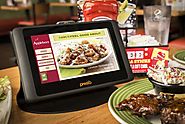
The universal sign for the check now includes a SWIPE
Who likes waiting for the check at a restaurant? Julia Stewart, the CEO of Applebee’s parent company certainly doesn’t.
She’s pulled the trigger last month to buy 100,000 tablets for Applebee’s. The chain has 5,000 in service currently, with plans to install another ninety-five thousand by the end of 2014. Patrons can not only pay checks without waiting for the server, but also play games and place orders.
“Customers have been telling us for some time—even myself … I don’t like to wait for the check,” said Stewart. “That was the first sort of pain point we heard of, and we had this unique opportunity with technology to make a real difference.”
The Numbers Don’t Lie
Here are some stats from early industry use:
There are also some other noteworthy increases. Customers are leaving faster, more satisfied and with a higher check total. Plus they now have a new option to keep customers and/or their kids occupied while they wait for food. The tablet is a WIN on about five different levels.

Taranta is a Peruvian inspired Italian restaurant in the North End of Boston. Taranta uses squid ink to place QR codes on plates using fresh locally sourced seafood. Diners can scan the code to visit ‘Trace and Trust’. It allows you to track where and when the fish was caught.
Talk about a signature extra. This one is signed in squid ink. Use a hot button technology to highlight the fact you source your seafood from local fishermen. Add in the fact that Taranta is one of the greenest restaurants in America.
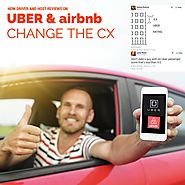
We’ve all seen this customer. He or she is rude to the staff, complains incessantly and becomes a general nuisance. Up until recently there was little or no recourse if you were a seller or service provider. You simply had to take it. These vampires drained employee morale and took the joy out of the equation for other customers.
The Rules Are Changing
Along came Uber and Airbnb. Following the footsteps of eBay buyer reviews, Uber allows drivers to rate customers and Airbnb allows hosts to leave reviews of guests. It is now transparent on both sides of the register. Technology has leveled the playing field. Your history as a buyer follows you from one transaction to the next. Poor behavior may keep you from getting a ride or staying at the apartment of your choice.
Will This Change The Behavior Of Customers?
Are customers now cognizant of their behaviors enough to improve? Perhaps… Back in June, Darren Rovell (@darrenrovell) shared a post from The Chive on Twitter. It was the story of an Uber customer. In his words,
Tonight, I got an Uber ride. After the driver was on their way, they sent me a text message telling me that they’re deaf and to keep that in mind. He picked me and headed home. On the way, I googled how to say, “Thank you very much” in sign language. When we got to my house and he pulled over, he turned back to look at me and I signed, “Thank you very much” and he started crying. He shook my hand firmly with two hands, wiped the tear from his eyes and signed back “Thank you” several times. Something simple that I did meant a lot to someone else. It was a good day.
It is doubtful that this passenger was motivated by a mere Uber rating. But it is reasonable to think that the knowledge of being observed will impact behavior. Researchers label this the Hawthorne effect. It is a type of reactivity in which individuals modify or improve an aspect of their behavior in response to their awareness of being observed.
Does Politeness Pay?
If politeness doesn’t pay, at least in one place rudeness will cost you extra. According to Trendwatching.com, there is a café in France that has implemented a pricing policy based on patron’s politeness. Patrons who greeted the barista at La Petite Syrah in Nice and used “please” were charged 1.40 euros/$2 for a cup of coffee; those who failed to use any pleasantries were penalized with a 7 euro/$10 price. Caveat emptor: the prices (with greeting) were clearly displayed on a board inside the café.
Bad Behavior Might Get You Booted In The Future
Bad customers beware. Companies who value employees are not going to put up with a pattern of misbehavior. According to James Heskett and Earl Sasser, companies such as ING Direct (now Capital One) stand up to protect their employees. The bank has an operating strategy based on a strong, effective culture is selective of new customers. ING Direct had a practice of firing thousands of customers every month. This strategy is especially important when customers abuse policies or make unreasonable demands. Zappos employs a similar strategy of firing customers who abuse policies or employees. It’s one of their core seven tenets of achieving exceptional customer service, “Fire customers who are insatiable or abuse your employees.“
With Uber and Airbnb, bad behavior will get you banned from the service altogether. Uber has confirmed that riders have been suspended or barred from using the app because of such behavior.
Three Takeaways:
Companies need to think about how to leverage technology to empower employees to rate customers.
Tracking customers will have the net effect of modifying and improving customer behavior.
Banning customers with bad behavior has the net effect of improving employee morale and improving overall customer service.
Today’s Lagniappe (a little something extra thrown in for good measure) – Thank to Danny Rosin for sharing this story. Liam Murphy from Cork was recently alone in Dubai on business. He hailed a taxi driven by an Indian-born driver named Shakiha to go to Abu Dhabi. Liam wanted to visit the Ferrari World theme park. On the ride he learned that his taxi driver had been taking tourists to the theme park for 14 years. When Shakiha revealed that he had never been inside the park, Liam offered to pay his $95 entrance fee and convinced him to join in. The pair rode a number of roller coasters, one of which was the fastest in the world at 150 mph.
I don’t believe Shakiha was able to give Liam a ranking, but this single gesture should qualify him for the taxi passenger Hall of Fame.
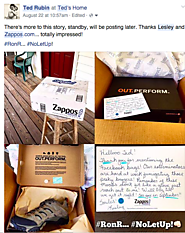
So unfortunate to see ads, from brands I respect, that are such #FAILS.
Good idea, I have been writing about hiking for when I am in Pine, AZ and was even interested in these shoes (so clicked on the ad), so “good Job” of matchmaking Facebook…
BUT who ever created this ad (probably an agency) and decided where it would link, truly DROPPED THE BALL. This is basic marketing/sales/advertising people… land me on the page with an offer for the product that enticed me to click, not on a general inventory page with this item no where in sight.
Guess what… I was gone in a heartbeat, and now have a bad taste in my mouth about Zappos, a brand I previously felt ok about. #RonR #NoLetUp
For me design, with regard to content and content marketing, is about ease of use, ease of access, and being certain about sending people to where they expect to go. Be careful about over designing for aesthetics that take away from your goal. And… if you are content marketing with an eye to getting me to click on a link or a photo of a product, be sure to land me on the page with an offer for the product that enticed me to click, not on a general inventory page with this item no where in sight.
Very cool that Zappos saw my post, even though I did not tag them, only mentioned them, and they reached out…
Conversation started August 14:
Lesley At Zappos
8/14, 6:08pm
Lesley At Zappos
Hello Ted! I’m so sorry and apologize for the ad not taking you directly to the hiking shoes. We appreciate your open and honest feedback. My heart hurts that you didn’t have a great Zappos experience while you were on line looking for hiking shoes! I’d like to turn that frown upside down. :)) I’m a Zappos Genie at your service! I know you weren’t expecting this, we’d like to get those out to you as a gift if we have them!! If we don’t, I’d like to send something similar. What type, style and size did you have in mind for those neat new shoes? Very much looking forward to hearing from you and I hope you accept my friend request. Smiles, Lesley
August 16
Ted Rubin
8/16, 3:18pm
Ted Rubin
Hey Lesley… thanks for reaching out, truly appreciate you guys paying attention. Please email about this to tedrubin@gmail.com… looking forward :-)
On Tue, Aug 18, 2015 at 10:46 AM, Lesley Durbin wrote:
Hi Ted,
Thanks much for messaging on Facebook! Zappos would love to deliver happiness with some great hiking shoes for you if possible! Which brand, style and size did you have in mind?? This would be a Zappos gift! It’s hard to believe I get to do surprises all day long AND get paid!
If you’re ever in Vegas, we sure would like to host a tour for you! We’re rockin self-organized work groups!
Have a delightful day!
Smiles :))))
Lesley
*I received the shoes (this is the story I was referring to in the Facebook post here)…
Screen Shot 2015-08-26 at 6.22.21 PM
AND… I am visiting Zappos Headquarters on September 30th.
On Fri, Aug 21, 2015 at 7:40 PM, Lesley Durbin wrote:
Howdy Ted, the 30th of September sounds perfectly perfect! We’ll be at the Mirage at 1 o’clock in a van wrapped in Zappos.com which is pretty hard to miss. As I mentioned earlier, we can be flexible, if something comes up just give a shout. Have a wonderful week! Smiles, Lesley
From: Ted Rubin
Sent: Thursday, August 20, 2015 9:00 PM
To: Lesley Durbin
Subject: Re: Zappos Gift
Let’s do it lunchtime, 1pm, on September 30th.
On Tue, Aug 18, 2015 at 10:46 AM, Lesley Durbin wrote:
If you’re ever in Vegas, we sure would like to host a tour for you! We’re rockin self-organized work groups!
AND then…
From: Ted Rubin
Sent: Wednesday, August 19, 2015 4:00 PM
To: Lesley Durbin
Subject: Re: Zappos Gift
I am truly impressed you guys actually fixed some of the ads already… seems the ones in the timeline are being directed properly (like the image attached) but the ones along the side on FB are still going to a general feed. Well done… feedback works! :-)
On Wed, Aug 19, 2015 at 5:02 PM, Lesley Durbin wrote:
Hi Ted,
Thank you for noticing the Facebook progress. Be assured, our team will be working on the ones along the side too!
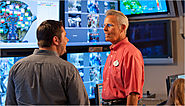
An article by the NY Times:
“Deep in the bowels of Walt Disney World, inside an underground bunker called the Disney Operational Command Center, technicians know that you are standing in line and that you are most likely annoyed about it.
Their clandestine mission: to get you to the fun faster.
Crowds line the way to Cinderella Castle at the Magic Kingdom.
To handle over 30 million annual visitors — many of them during this busiest time of year for the megaresort — Disney World long ago turned the art of crowd control into a science. But the putative Happiest Place on Earth has decided it must figure out how to quicken the pace even more. A cultural shift toward impatience — fed by video games and smartphones — is demanding it, park managers say. To stay relevant to the entertain-me-right-this-second generation, Disney must evolve.
And so it has spent the last year outfitting an underground, nerve center to address that most low-tech of problems, the wait. Located under Cinderella Castle, the new center uses video cameras, computer programs, digital park maps and other whiz-bang tools to spot gridlock before it forms and deploy countermeasures in real time.
In one corner, employees watch flat-screen televisions that depict various attractions in green, yellow and red outlines, with the colors representing wait-time gradations.
If Pirates of the Caribbean, the ride that sends people on a spirited voyage through the Spanish Main, suddenly blinks from green to yellow, the center might respond by alerting managers to launch more boats.
Another option involves dispatching Captain Jack Sparrow or Goofy or one of their pals to the queue to entertain people as they wait. “It’s about being nimble and quickly noticing that, ‘Hey, let’s make sure there is some relief out there for those people,’ ” said Phil Holmes, vice president of the Magic Kingdom, the flagship Disney World park.
What if Fantasyland is swamped with people but adjacent Tomorrowland has plenty of elbow room? The operations center can route a miniparade called “Move it! Shake it! Celebrate It!” into the less-populated pocket to siphon guests in that direction. Other technicians in the command center monitor restaurants, perhaps spotting that additional registers need to be opened or dispatching greeters to hand out menus to people waiting to order.
“These moments add up until they collectively help the entire park,” Mr. Holmes said.
In recent years, according to Disney research, the average Magic Kingdom visitor has had time for only nine rides — out of more than 40 — because of lengthy waits and crowded walkways and restaurants. In the last few months, however, the operations center has managed to make enough nips and tucks to lift that average to 10.”
Takeaway: They say (whoever they are) that on any given day we spend 10% of our life waiting. That number is probably more like 30% when you visit an amusement park. Disney knows waiting is inevitable. Here are 3 takeaways on how Disney manages waiting to improve the customer experience:
Maximize capacity
Direct flow
Entertain, entertain, entertain

Biometric authentication apps for financial apps are expected to be all the rage by 2019, and USAA wants to be part of the trend.
The Texas-based financial services company said that it is going to soon be rolling out the option of using voice and facial recognition to its customers when they log into accounts through their mobile device. The mobile app already has a unique PIN, but this addition will add the multifactor authentication process by generating the option to use facial and voice recognition to log in as well.
“The use of multifactor authentication through biometrics is one of the most effective ways to increase security protection as traditional passwords become increasingly obsolete,” Gary McAlum, USAA’s chief security officer, told FinExtra.
Here’s how the authentication process will work for USAA customers: A user will log in to the home screen and will be asked to blink their eyes. To activate voice authentication, users must read a short phrase. USAA is currently launching the service as a pilot test in California, Texas and Florida; a nationwide rollout is expected to follow. The new option will be available via an app update on both iOS and Android devices. Fingerprint identification is what the company will test next, McAlum said.
A report released yesterday (Jan. 20) from Juniper Research, said that there will be nearly 770 million biometric authentication apps downloaded per year by 2019, which is quite the increase from the 6 million per year currently. Juniper credits the expected surge in these downloads to the current proliferation of Touch ID hardware in Apple and Samsung smartphones, as well as the linking of the hardware to tokenization of NFC payments in mobile commerce.
In comparison, in Europe the trend is already here. In a survey published by Visa Europe, FinExtra said that 75 percent of consumers in the age range of 16-24 said they are in favor of biometric security options like facial recognition, fingerprint and retina scanning over passwords.
Source: http://www.pymnts.com/news/2015/voice-facial-recognition-coming-to-usaa-mobile-log-in/#.VeNITLxVhBc

China’s largest Amazon-like e-store, Jingdong, has just rolled out two new supercharged delivery options in six major cities. The night delivery option means that office workers can buy online up to 3pm and have the items arrive at their home between 7pm and 10pm. Even quicker than that is the new three-hour delivery service.
The two options became available last night, Jingdong tells us, but will only be announced and publicized later tonight. The six cities covered for both options are Beijing, Shanghai, Chengdu, Wuhan, Shenyang, and Guangzhou. More cities will be supported in due course. Extra fees are applied for the speedier 3-hour option only (Update: Corrected this detail).
The three-hour delivery represents what’s likely the quickest delivery option in China.
Jingdong – formerly called 360Buy – has what it calls a “last-mile” courier network of vans and e-bikes of its own, launched last summer, to take items from its city warehouses direct to the door of buyers. That means it’s not reliant on third-party couriers.
Source: https://www.techinasia.com/china-jingdong-begins-3-hour-delivery/

Intuit defines the reasoning behind the value of Innovate and Improve as,
“We innovate to drive growth, and continuously improve everything we do. We move with speed and agility, and embrace change. We have the courage to take risks, and grow by learning from our successes and failures.“
He cites Intuit’s innovative service for TurboTax. A bold move that offered free tax advice. In Bob’s words,
Surely Intuit would only make this available to its paying customers. Or set up some kind of premium subscription. You can’t just give this away, right? Well, yes they can, and did. The idea came from observing that customers looked to TurboTax as a source for answers on how to use the software, but not tax advice. This raised the question, according to product manager Katie Hanson, “Could we do more?” With support from an aggressive General Manager, they decided to market it as “we give tax advice” with no use of an Intuit product required.
Since the tax advice service involved hiring hundreds of agents, it was very risky. But Intuit believed it would increase customer loyalty and drive new product sales. Leaders were willing to take a (calculated) risk to add value to existing customers and potential customers. If this strategy stops working and a better approach appears, they won’t be afraid to move on.
TurboTax Support Contact Us Page – Get Help from TurboTaxWith my too-good-to-be-true warning light flashing, I tried it out with a real tax question that’s been bugging me. After typing in my question, I got a list of possible answers from their online knowledgebase, followed by options to contact Intuit through its TurboTax community, online chat, and phone. Delightful. If you’re already a TurboTax customer, this service will keep you one for life. If not, the next time you’re in the market for tax software, you’ll be buying from Intuit.
Source: Bob Thompson, CustomerThink
Are you offering MORE, the little extras that drive loyalty? Jay Baer has a classic line from his latest book Youtility,
“Sell something, and you make a customer. Help someone, and you make a customer for life.“
How are you helping your customers and prospects like Intuit? Could you be doing MORE?

“Izzy’s Ice Cream Cafe of St. Paul serves over 150 flavors of handmade ice cream and always keeps 32 flavors in the case on any given day. I talked with Jeff Sommers today and he is super passionate about his ice cream and providing great customer service to serve it up.
Here’s what was happening at Izzy’s:
When customers came to his store, they wanted to taste their favorite ice cream flavor. Sometimes it was not yet available and so people would leave feeling disappointed. Some people would purchase a different flavor, but Jeff really wanted total customer satisfaction and he searched for a way to provide it.
Finding a way to let the patron know when their favorite flavor was available, reducing disappointment, was a prime concern for Jeff. It was a problem he needed to solve right away. The day he found a RFID technology solution for that problem was the day revenue increased. He had solved the problem and provided added value. RFID tags identify each flavor when it is placed in the case ready to serve. The RFID system updates the inventory every 3 minutes so you can be sure your favorite flavor is there when you are craving.
If you choose to be notified by email, you can sign up and let the system know what flavors you are looking for. There are options to be notified by Twitter updates and Facebook alerts as well. Just sign up for the updates.
The effort of Jeff in finding a solution for his customer is remarkable. I find it one of the most unique ways of using RFID tagging technology and bringing top notch customer service to a business.
When owners like Jeff go out of the way to serve their customer, I believe it’s a story worth telling over and over again.”

OBJECTIVES
In 2010, the Tampa Bay Lightning were in the midst of a failing economy and were watching season ticket sales decline due to various issues. Fortunately for the team, the Lightning were purchased by philanthropist Jeff Vinik who gave huge resources for the team to become more cutting edge. Brad Lott, Executive Vice President of Service and Operations for the Tampa Bay Lightning, believes, "When Mr. Vinik purchased the team, he gave us the opportunity to be competitive in the future. From there, it was about what we could dream up to get people excited again." With a bright outlook for the future, the Lightning set out to get their season ticket base to 10,000 regardless if they won or lost on the ice.
PROGRAM DESCRIPTION
To create added value for season ticket holders, the Tampa Bay Lightning created a revolutionary jersey to give to all full-time season ticket holders during the 2011-12 National Hockey League season. To give the jerseys a distinct look and subsequently unite fans at home games, the Lightning adorned the jerseys with a "season ticket member" patch and allowed fans to customize the jerseys with their own name and number. Due to Tampa Bay's desirable climate and large number of travelers, it's not uncommon for out-of-town jerseys to outnumber Lightning jerseys in the stands. Giving away these special jerseys to the season ticket holders helped to increase team colors at Lightning games at the Times Forum.
In addition to making them feel like a member of the team, the Lightning wanted to incentivize their most loyal fans to purchase while in stadium. "Season ticket members commit 41 nights a year to be in our building, so we felt they deserved benefits that no one else could receive," said Lott. "We noticed that season ticket holders weren't buying food in-stadium, they were opting to eat out and we wanted to incentivize them to try out our new offerings." To get them to buy in-stadium, the team embedded RFID chips into the sleeve of each jersey. The chips can be scanned throughout the stadium for an exclusive discount: 25% off concessions and 35% off merchandise. Lott describes the creation of the promotion, "It started as a joke, someone mentioned putting a chip in our fans, but then we realized we could make this a reality." The Lightning partnered with Quest and Radiant Systems to create the RFID chips. Quest and Radiant Systems created a durable chip about the size of a quarter that can be dry-cleaned, ironed and washed 10,000 times.
Confident in the RFID chips ability to work, the team installed an RFID reader at every Point-of-Service station in the Times Forum building. The reader scans the chip, automatically recognizes who the season ticket member is and gives them their discount. The transaction information is recorded by Quest who then provides the information to the Lightning. The chip numbers are associated with account numbers and the team is able to see buying patterns and where season ticket members are buying from. This information allows the team to better understand their consumers to create smarter, more effective promotions. "The beauty of this system is that it is segmented out based on the area of the arena that a season ticket holder sits in. It gives us the ability to do promotions based on segmented areas throughout the arena," adds Lott.
sports marketing
Tampa Bay Fans wearing their RFID "Season ticket member" jerseys.
MEDIA
To advertise the RFID jerseys, the Lightning did an intricate pre-season campaign using both traditional and non-traditional media to make sure they covered all bases. They advertised in-arena, online, through social media, radio, TV, print, and via their sales staff. They left no stone unturned.
PARTNERS
The Lightning partnered with Quest and Radiant systems to create the RFID chips that were placed in the sleeves of the season ticket member jerseys. They did not bring on any sponsors for this promotion.
RESULTS
The RFID jerseys have been a huge success and as a result, the Lightning has seen all of their revenue categories go up. Season ticket sales have increased from last year's 6,000 to 11,000 this season. Additionally, all merchandise and concession sales have increased 25% substantially.
sports marketing
Season ticket "members" taking advantage of the promotions 25% off concessions.
To see what else the Tampa Bay Lightning are up to, click here.
LOOKING AHEAD
Being the first team to use this technology, the Lightning had to pioneer the way for other teams to begin using RFID to identify fans and give exclusive offers. Now that they know the technology is popular with their fans, they will begin to improve the system to make it make more turn-key. "The technology in an RFID chip is similar to a credit card. You can store whatever you want, essentially whatever you can dream up," adds Lott. No one knows for sure what the Lightning will dream up next but one thing is for certain...they will continue to use this promotion in the future.
Source: http://sports-forum.com/news/new_archive/index.html?article_id=453#sthash.ZWyBo6Et.dpuf
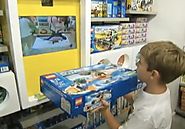
Lego stores solved the challenge of customers wondering what the Lego model within the box would actually look like. The in store technology which was first piloted back in 2009 allows customers to hold Lego boxes in front of a screen, and, once the camera detects, a 3D animated model that is in the box appears on the screen which, as a customer rotates the box, the model rotates with it. The whole experience allows the customer to view the product from all angles whilst very naturally rotating the box which the customer has just pulled off the shelf.
The remains an example of the most innovative uses of augmented reality in stores. Lego continue to capture 3D versions of the models they sell and the hardware continues to function in all of their stores worldwide.
The technology is from Munich based augmented reality specialist metaio, who also have some large clients like Honda, Mini & Adidas
Source: http://retail-innovation.com/augmented-reality-in-lego-stores/
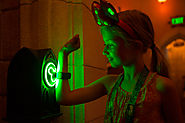
If you want to imagine how the world will look in just a few years, once our cell phones become the keepers of both our money and identity, skip Silicon Valley and book a ticket to Orlando. Go to Disney World. Then, reserve a meal at a restaurant called Be Our Guest, using the Disney World app to order your food in advance.
The restaurant lies beyond a gate of huge fiberglass boulders, painstakingly airbrushed to look like crumbling remnants of the past. Crossing a cartoon-like drawbridge, you see the parapets of a castle rising beyond a snow-dusted ridge, both rendered in miniature to appear far away. The Gothic-styled entrance is teensy. Such pint-sized intimacy is a psychological hack invented by Walt Disney himself to make visitors feel larger than their everyday selves. It works. You feel like you’re stepping across the pages of a storybook.
If you’re wearing your Disney MagicBand and you’ve made a reservation, a host will greet you at the drawbridge and already know your name—Welcome Mr. Tanner! She’ll be followed by another smiling person—Sit anywhere you like! Neither will mention that, by some mysterious power, your food will find you.
“It’s like magic!” a woman says to her family as they sit. “How do they find our table?” The dining hall, inspired by Beauty and the Beast, features Baroque details but feels like a large, orderly cafeteria. The couple’s young son flits around the table, like a moth. After a few minutes, he settles into his chair without actually sitting down, as kids often do. Soon, their food arrives exactly as promised, delivered by a smiling young man pushing an ornately carved serving cart that resembles a display case at an old museum.
It’s surprising how the woman’s sensible question immediately fades, unanswered, in the rising aroma of French onion soup and roast beef sandwiches. This is by design. The family entered a matrix of technology the moment it crossed the moat, one geared toward anticipating their whims without offering the slightest clue how.
How do they find our table? The answer is around their wrists.
Their MagicBands, tech-studded wristbands available to every visitor to the Magic Kingdom, feature a long-range radio that can transmit more than 40 feet in every direction. The hostess, on her modified iPhone, received a signal when the family was just a few paces away. Tanner family inbound! The kitchen also queued up: Two French onion soups, two roast beef sandwiches! When they sat down, a radio receiver in the table picked up the signals from their MagicBands and triangulated their location using another receiver in the ceiling. The server—as in waitperson, not computer array—knew what they ordered before they even approached the restaurant and knew where they were sitting.
And it all worked seamlessly, like magic.
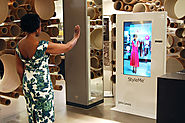
At the John Lewis department store in London, would-be fashionistas don’t have to change clothes before trying on new outfits.
Hanah Ebdon, 19, stood in front of a full-length digital mirror situated in the women’s wear department at the flagship John Lewis Partnership Plc store on Oxford Street. She used hand motions to swipe from one brand to the next, seeing how she looked in a blue dress, then a patterned one, projected onto her reflection. “People will see it initially as more of a gimmick,” says Ebdon, whose skinny jeans showed below the dress. Still, she says, “it’s better than online shopping.”
http://www.bloomberg.com/bw/articles/2012-04-30/keeping-the-customer-digitized
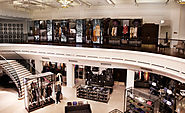
Astute stores and brands like Burberry understand that shopping is much more than a practical way to buy goods. They know that shopping is, and has always been, an immersive and emotional journey.
As a result of geniuses like Field and Boucicaut, the store became not just a place for you to buy goods, but a sensory, tactile imaginarium, making that rarefied experience of luxury accessible to the emerging middle-class of the Gilded Age.
Even today, retail is a carefully choreographed dance. As you wander through stores, its principles are quietly in motion, whether it’s baby powder wafting through air conditioning to lull you into buying fluffy bedding or seemingly random layouts designed to catch and intrigue your eye, even when you glance down. Meanwhile, tech innovations — whether dazzling video displays or more hidden sensors and chips designed to send data to customers — are simply new ingredients in an age-old recipe centered on retail showmanship and service.
With a wraparound digital wall, Burberry’s flagship has enough spectacle to make Boucicaut proud. It was designed to create an immersive digital experience — that art-slash-fashion design that immediately strikes your eye. You can even interact with select content with your iPhone or iPad, as if the store itself was one giant app. Beyond the wall, screens are everywhere — there’s over 100 of them, include the world’s largest indoor retail display, flanked by about 500 speakers. As you wander throughout the store, even mirrors transform into content displays — an elegant swipe animation creates a constant dance of visuals that respond to your movements.
Beyond what you can see, Burberry uses technology in less obvious ways. The company integrated radio-frequency identification, or RFID, tags into items to give you a window into its inner workings. When you walk up to a fitting room mirror with item in hand, for example, information about its craftsmanship pops up. If it’s in a fashion show, a catwalk video appears, showing you how to wear it as well. Not only is it good salesmanship, it’s also a valuable way for Burberry to communicate its values of heritage and artisanal craftsmanship — tenets that came well before the creation of mobile devices.
Of course, every brand tries to convey its identity, but Burberry does it in a way that creates the magic and enchantment at the heart of in-store shopping — a trick taken from Boucicaut and Field.
Browsing inside the flagship feels like you’re wandering inside the Burberry.com website, and that’s precisely what the company wants. Rather than make a website to mirror the store, the brand took a “digital-first” approach to its flagship, one to capture the attention of a generation whose experiences are as much online as they are off. It translated its digital journey into a multimedia-infused physical space.
Burberry didn’t just build a sleek, stylish website to amass a following for its live runway feeds. It also created digitally-based services, such as a bespoke trench tailoring that lets you design your own coat over iPads — with the help of a sales associate. Burberry designed its supply chain so you can order fresh-off-the-catwalk designs as soon as they’re shown — you’ll get them mere weeks after their Fashion Week debuts.
Source: http://2machines.com/179111/

Anonymous video analytics (AVA) is a strategy for gathering metrics about digital signage audience engagement.
In the past, marketers could only gather data about how many people passed by a digital sign. The problem with this method is that many people pass by a digital sign without looking at it.
Anonymous video analytics uses embedded camera sensors and a program for analyzing mathematical algorithms to detect a passing face that turns towards the sign. Unlike facial recognition software, AVA does not match a particular face to a face in a database. (This is what makes it anonymous.) Instead, AVA relies on a technique known as pattern detection. The AVA program consults a database of pixel patterns to determine when something in front of the sign is a human face looking in the right direction. In very simple terms, the program looks for patterns such as dark pixels where eyes should be and lighter pixels where cheeks should be.
Once the AVA program has determined that the pixel patterns are of a human face, the program can record how long the face looked at the sign. It may also categorize the face according to demographic groups, such as gender and age.
This Intel video clip demonstrates how CognoVision's AVA works. https://www.youtube.com/watch?v=1t_w8JiQ-gc
Source: http://whatis.techtarget.com/definition/anonymous-video-analytics-AVA
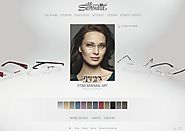
Silhouette presents an online service that allows to virtually try on glasses from one’s own computer. Virtual Mirror is part of the Silhouette Rimless Aesthetics Program, launched worldwide in spring 2009. In collaboration with the Mary Greenwell make-up artist, Silhouette developed a simple and unique aesthetic concept, that shows of the acts necessary to choose the right glasses’ model, perfectly fitting one’s own face. The service is free of charge on the website www.silhouette.com
Whoever wears the glasses will have the chance to choose the Silhouette through the online system. Anybody will have the chance to choose the models, try out new colors and test new shapes of lenses in a variety of almost-infinite combinations. Like this it’ll be possible to select the preferred glasses before going to the optician.
Accessing the website www.silhouette.com/virtualmirror every user will have the chance to upload his own picture and virtually try on his own face the Silhouette models, selecting them from a wide range of lenses’ shapes and colors. Every mode is in fact available in different colors and in different lenses’ shapes. This variety allows the user to try the entire range of Silhouette glasses on his face and to evaluate which is the model that best suits his look and physical features.
Once decided the preferred Silhouette glasses, the user will have the option of printing the picture and take it to the optician to try, in person, the model he had created on the web.
Source: http://www.luxgallery.com/luxury/silhouette-personalized-glasses-on-the-internet/408/

Employee productivity has moved to the forefront as a key strategic issue for businesses of all sizes. How can business owners boost workforce productivity without incurring additional operating costs?
Equip employees with the technology to work from anywhere. As business continues to move beyond the traditional 9-5 day and across borders and time zones, small businesses need to leverage technology to maximize every minute of their time. In addition to mobility devices, simple, affordable online access and collaboration tools will enable even the smallest companies to run their business and engage their workforce and customers from any place. Employees can collaborate in real time with remote co-workers, cut travel costs for unnecessary in-person meetings, conduct remote training and support sessions from anywhere, and keep in close touch with customers more efficiently and cost-effectively.
Those of us lucky enough to work at organizations that support virtual workstyles—a trend my company calls "workshifting"—already understand the benefits: increased productivity via reduced stress, better work-life balance, increased motivation, healthier lifestyles, and so forth. If you’re looking to boost your workforce productivity and save money in the process, it’s time to start taking a closer look at how workshifting practices can benefit your organization, your employees, and even the economy as a whole.
Sharing and experience are much different today than it was in the 1990's.

Stan Phelps is a Forbes Contributor, IBM Futurist, and TEDx Speaker. His keynotes and workshops offered at PurpleGoldfish.com focus on how to create meaningful differentiation to win the hearts of both employees and customers. He’s the best-selling author of: Purple Goldfish -12 Ways to Win Customers and Influence Word of Mouth, Green Goldfish - Beyond Dollars: 15 Ways to Drive Employee Engagement, Golden Goldfish - The Vital Few, Blue Goldfish - Using Technology, Data, and Analytics to Drive Both Profits and Prophets, Purple Goldfish Service Edition - The 12 Ways Hotels, Restaurants and Airlines Win the Right Customers, and Red Goldfish - Motivating Sales & Loyalty With Shared Passion and Purpose. Connect with me at stan@purplegoldfish.com or +1.919.360.4702.